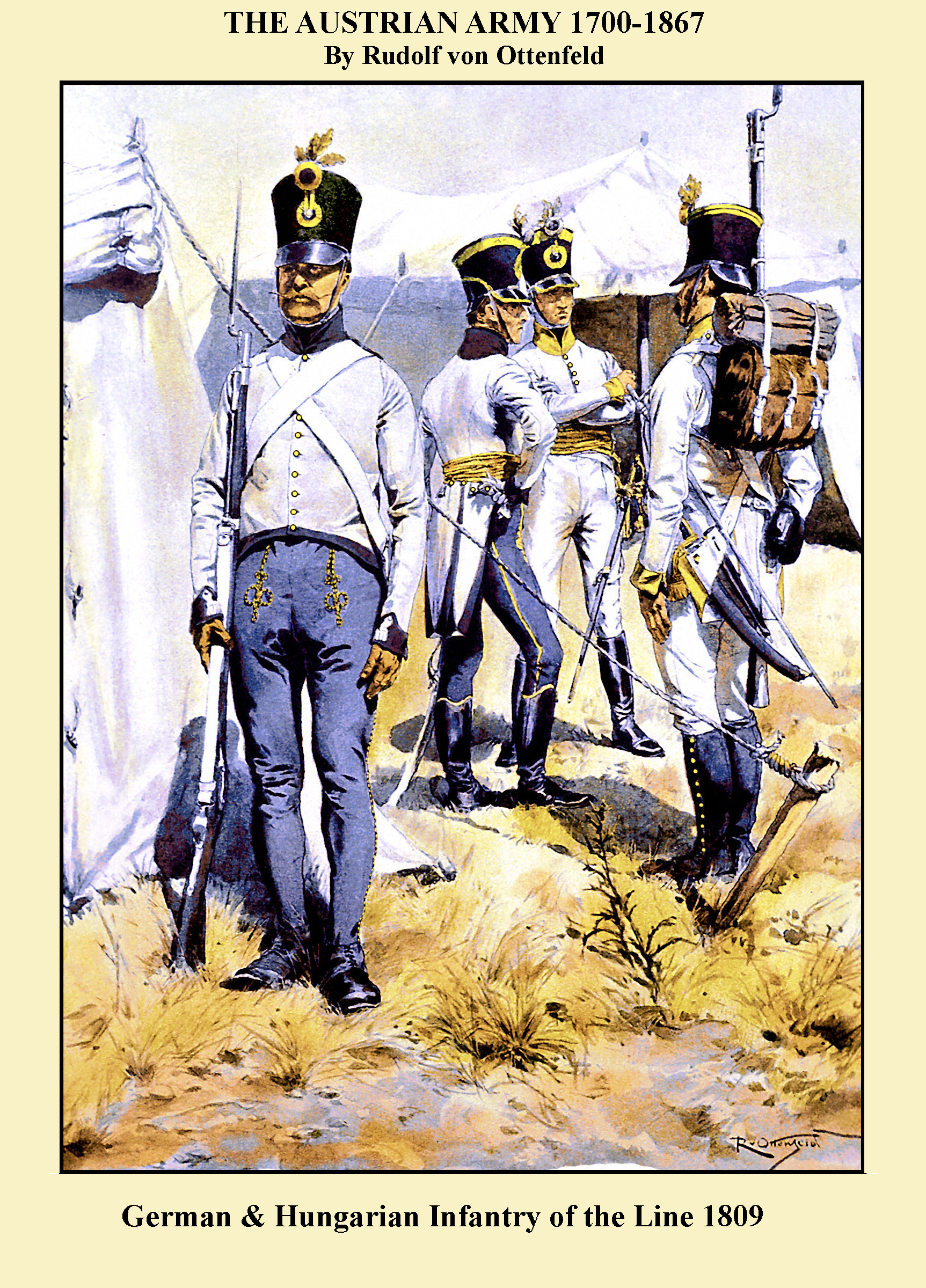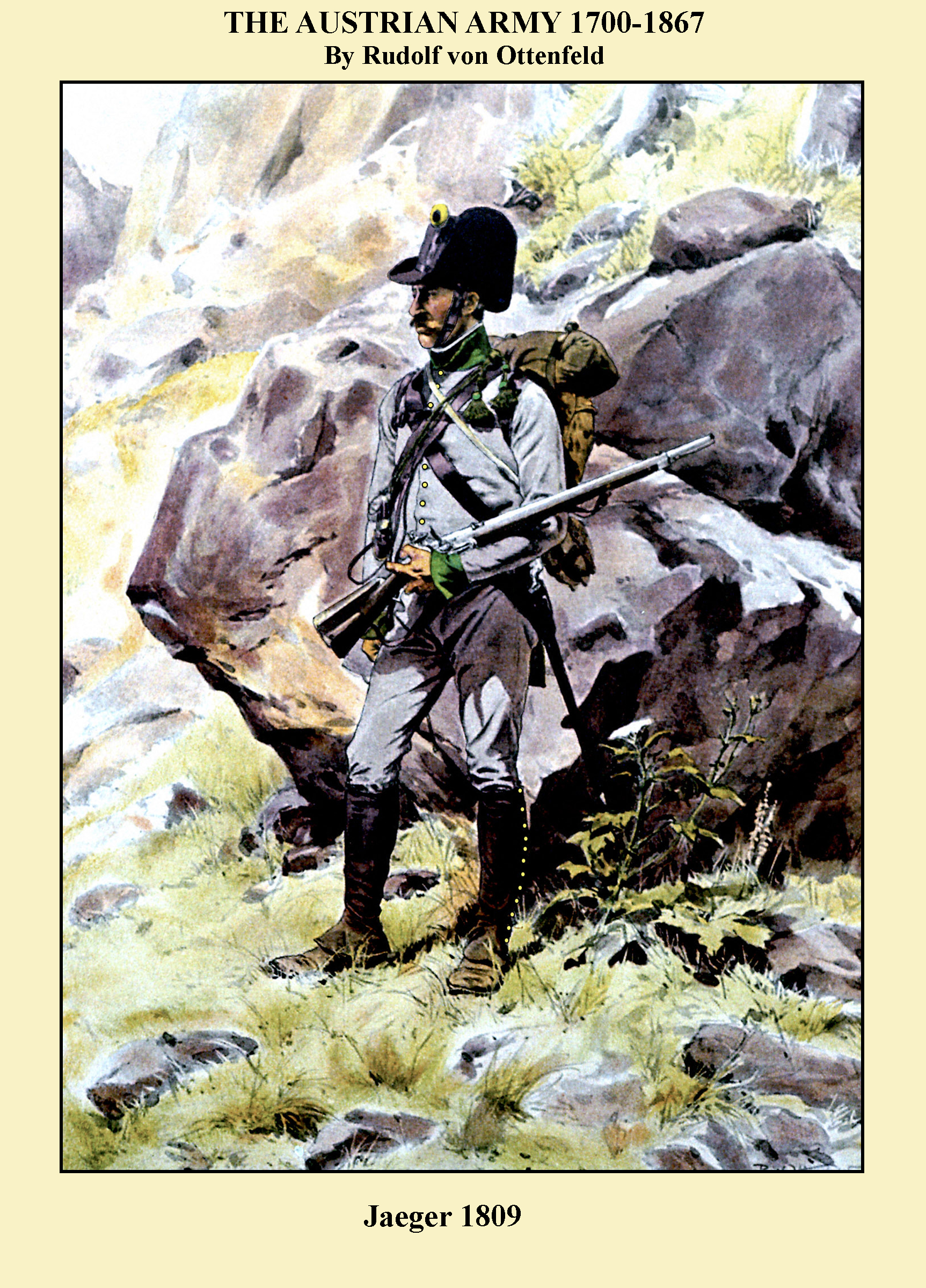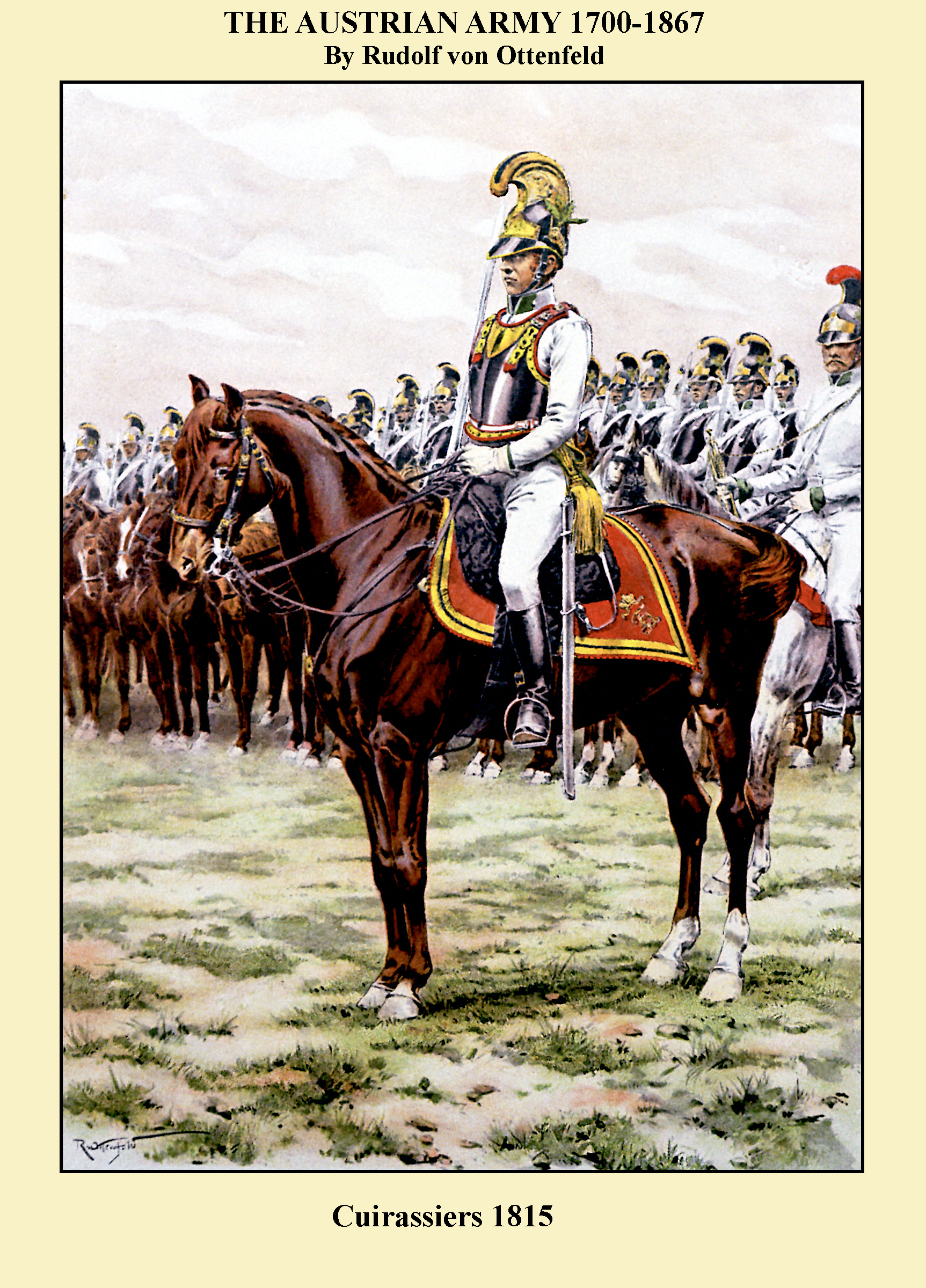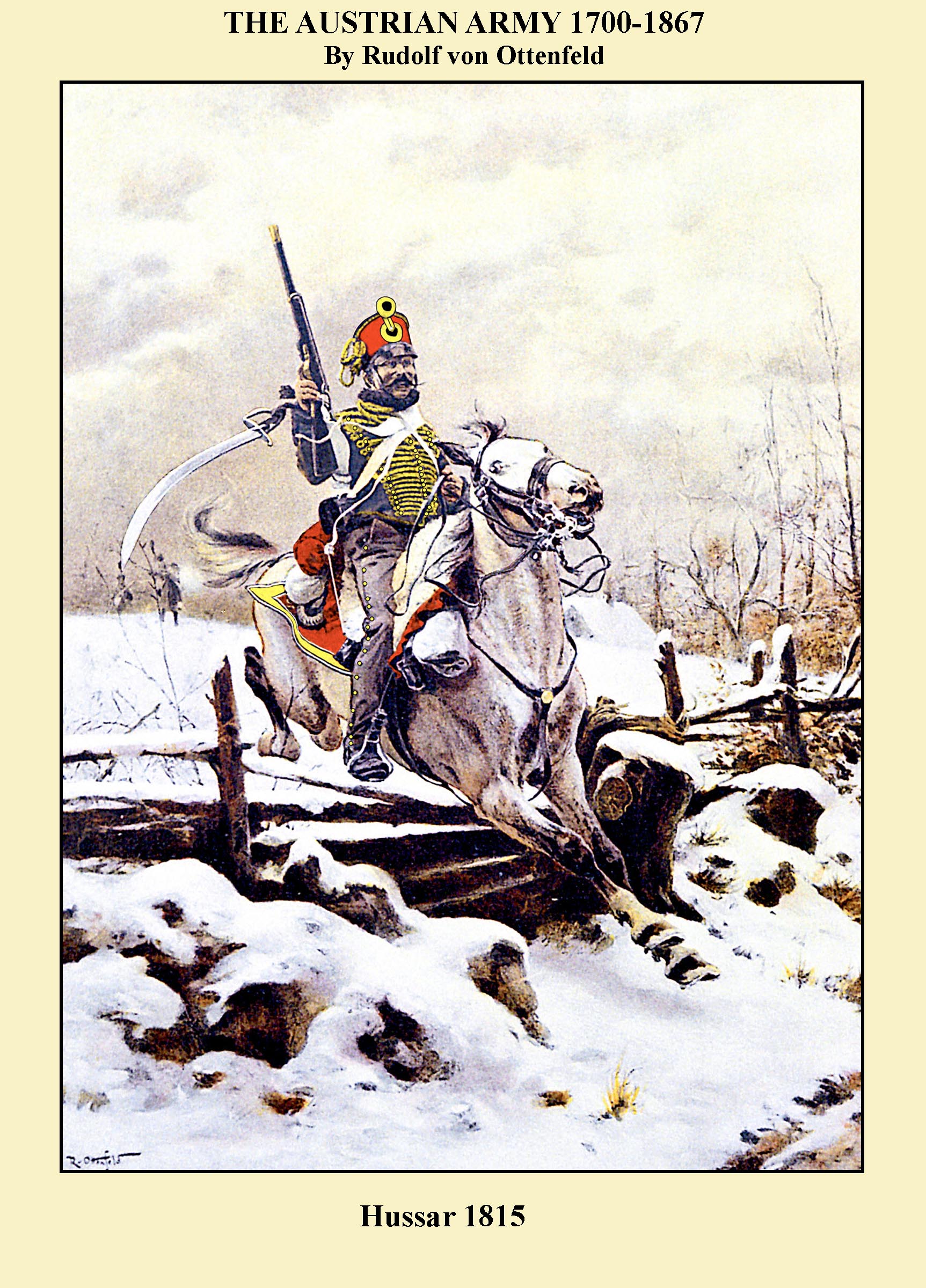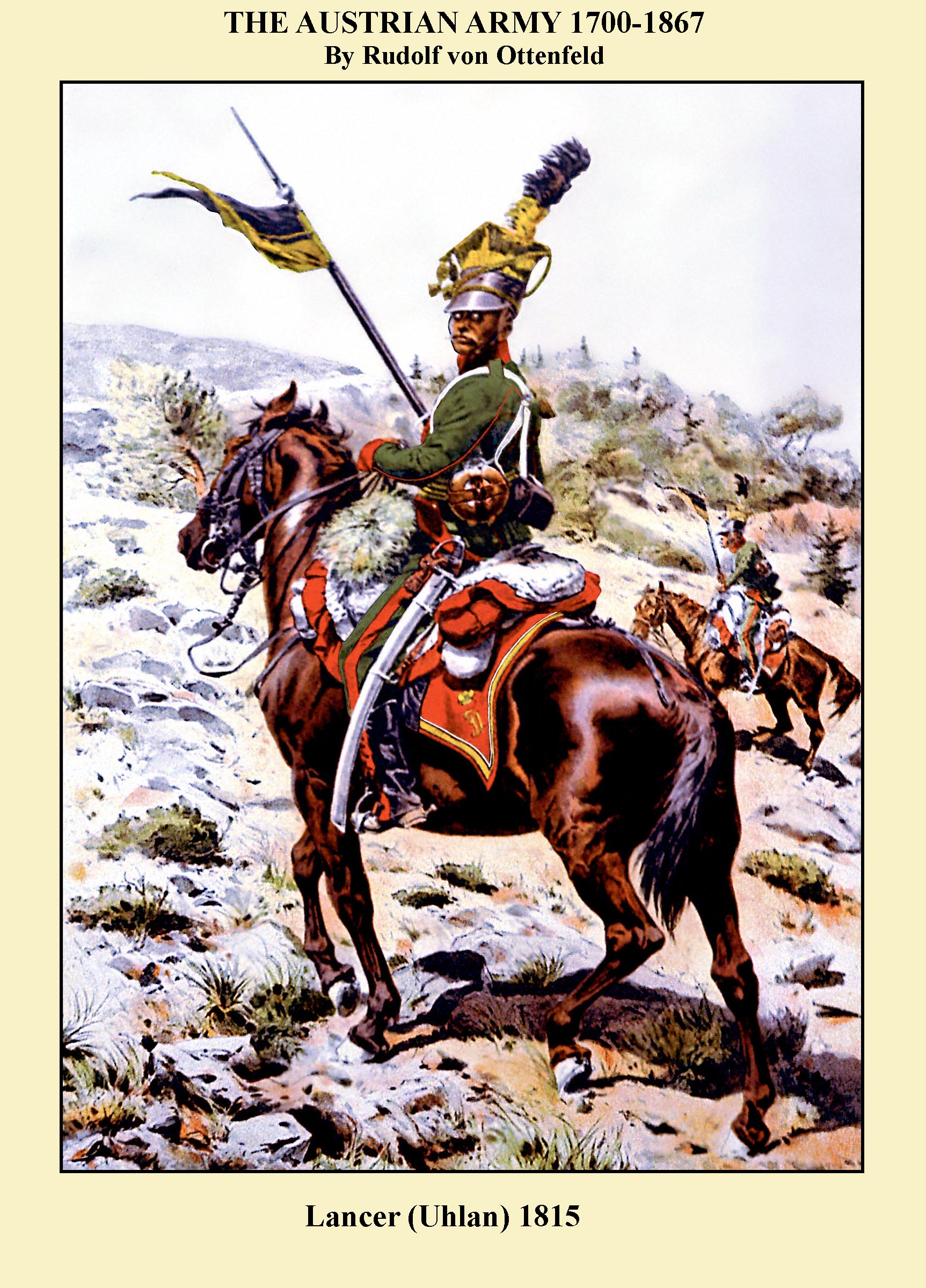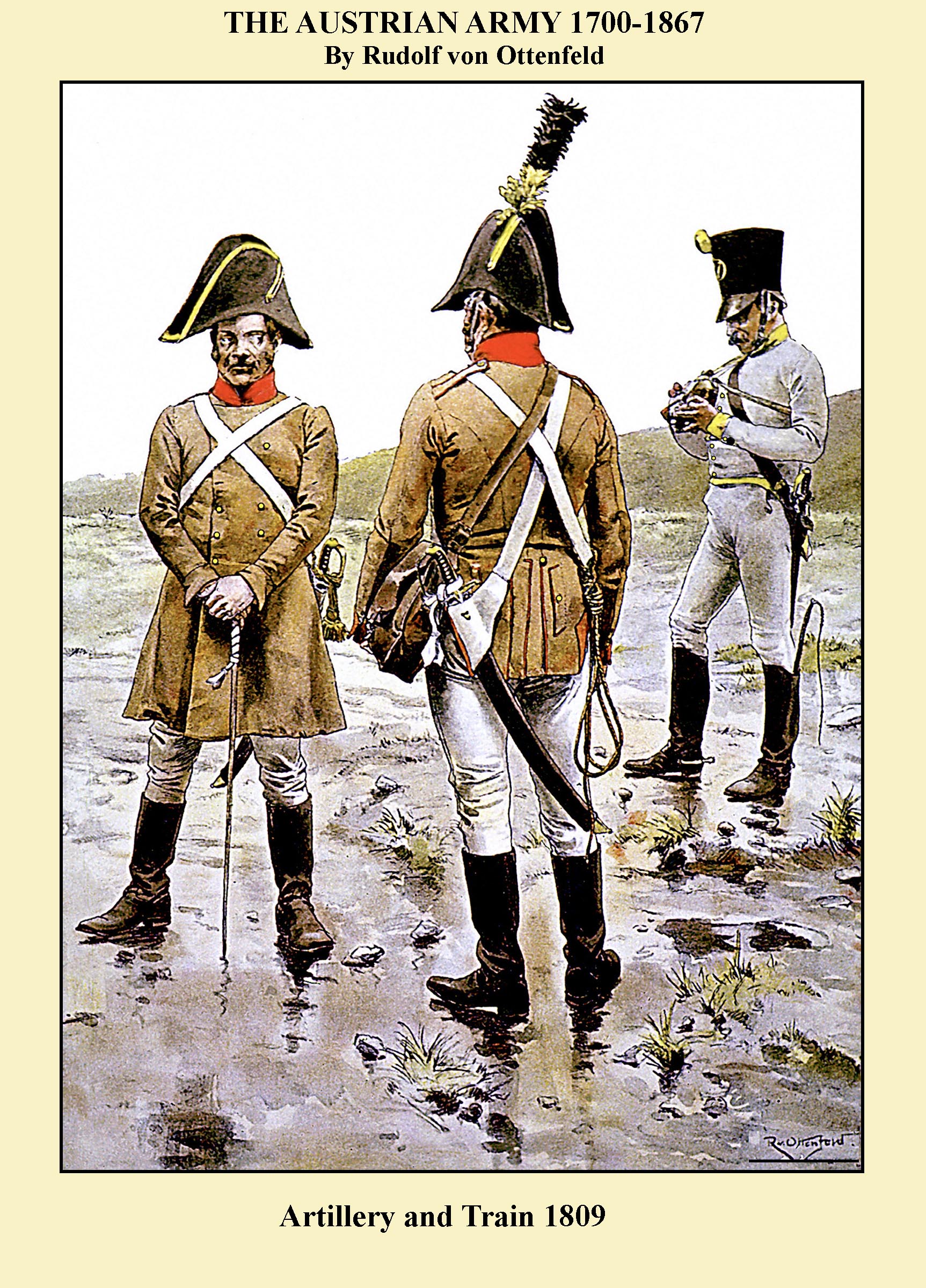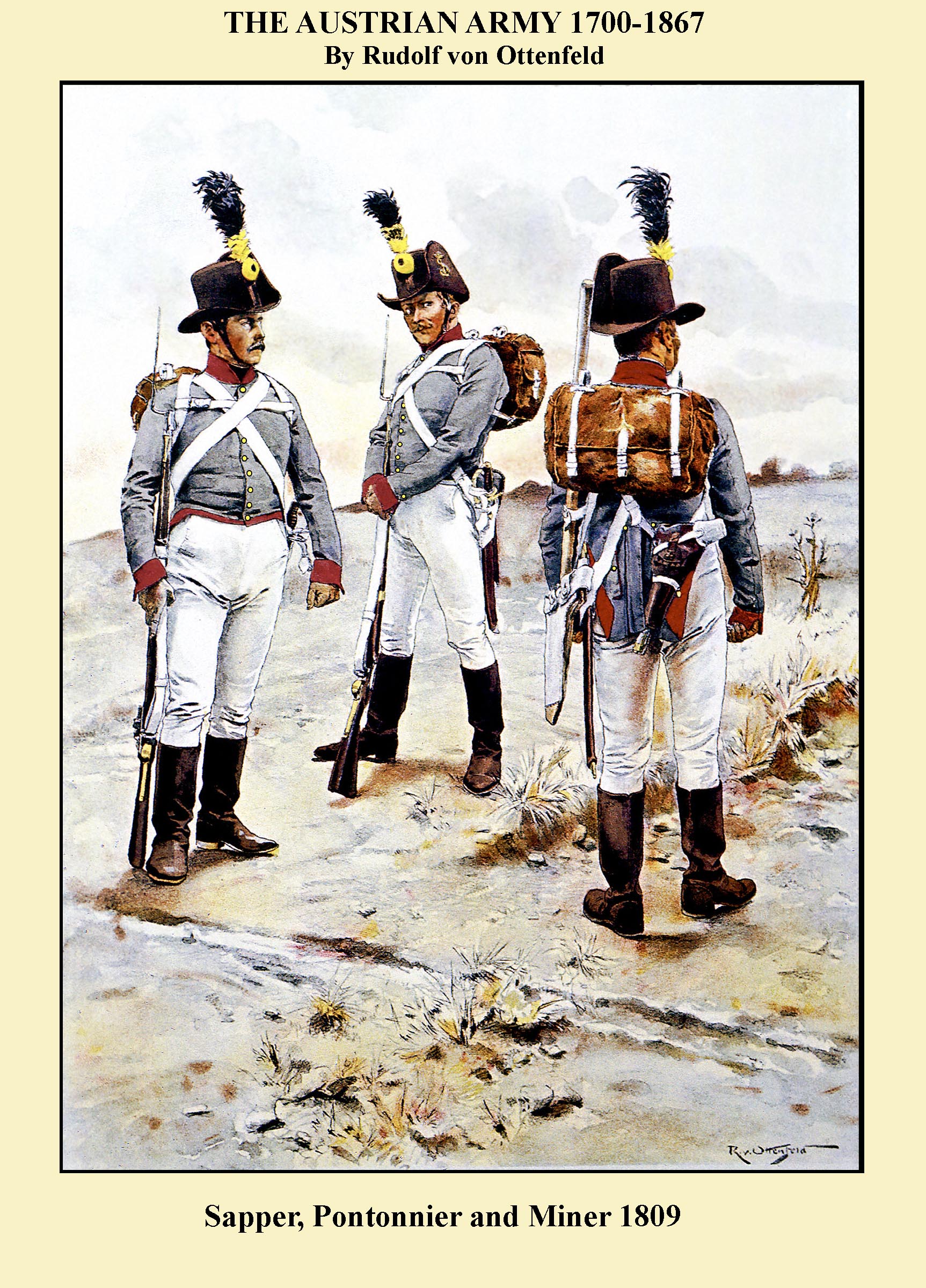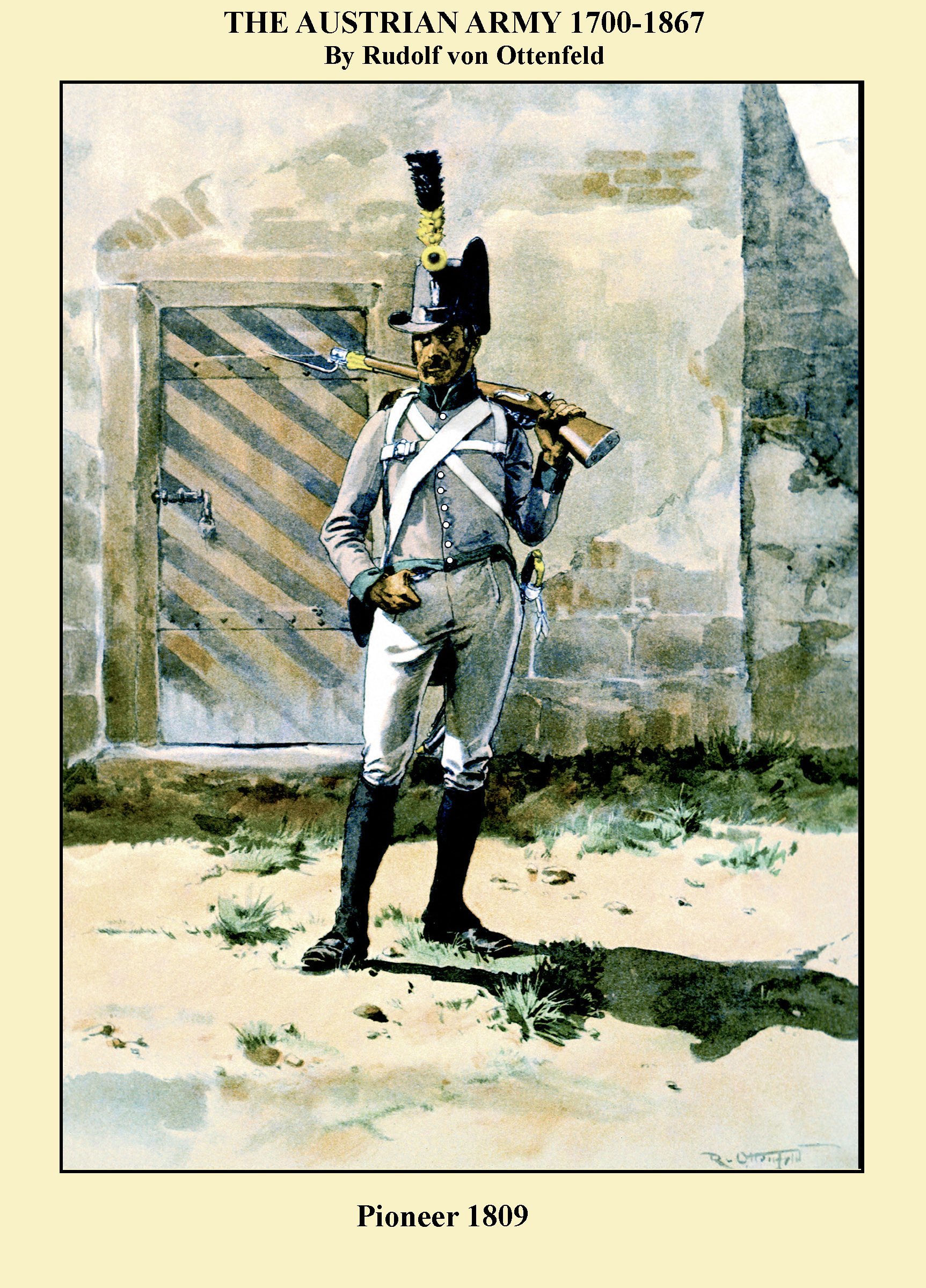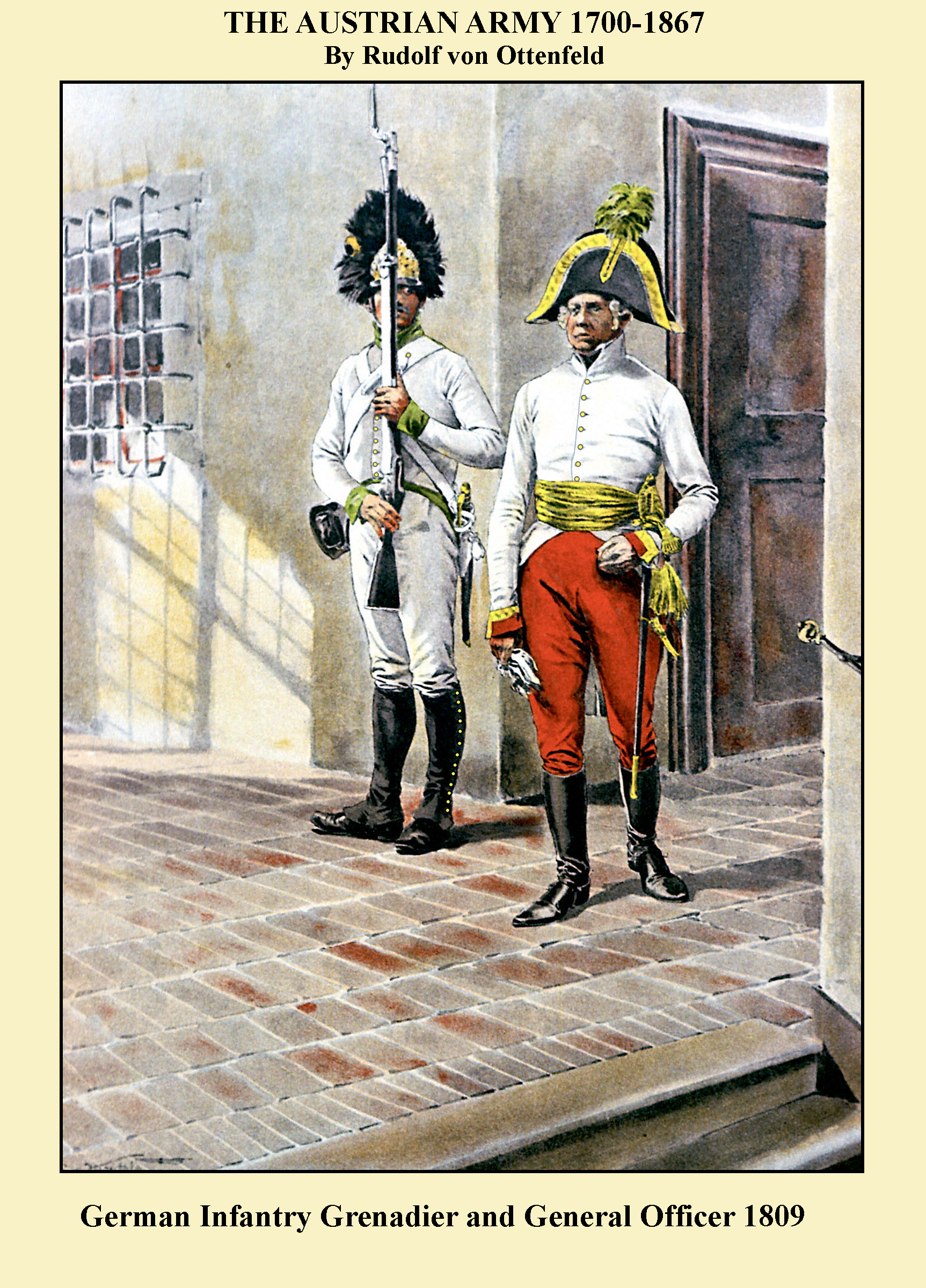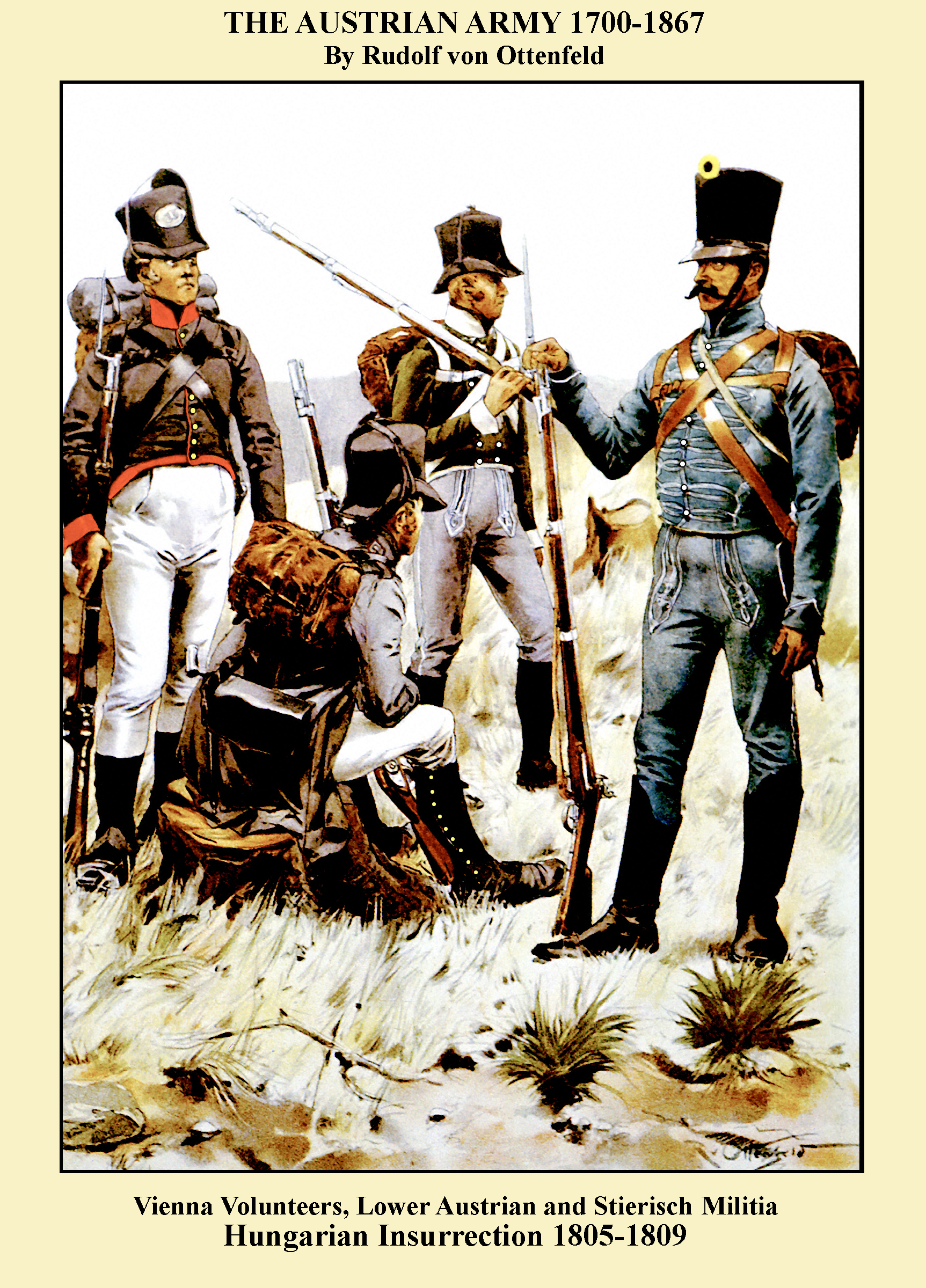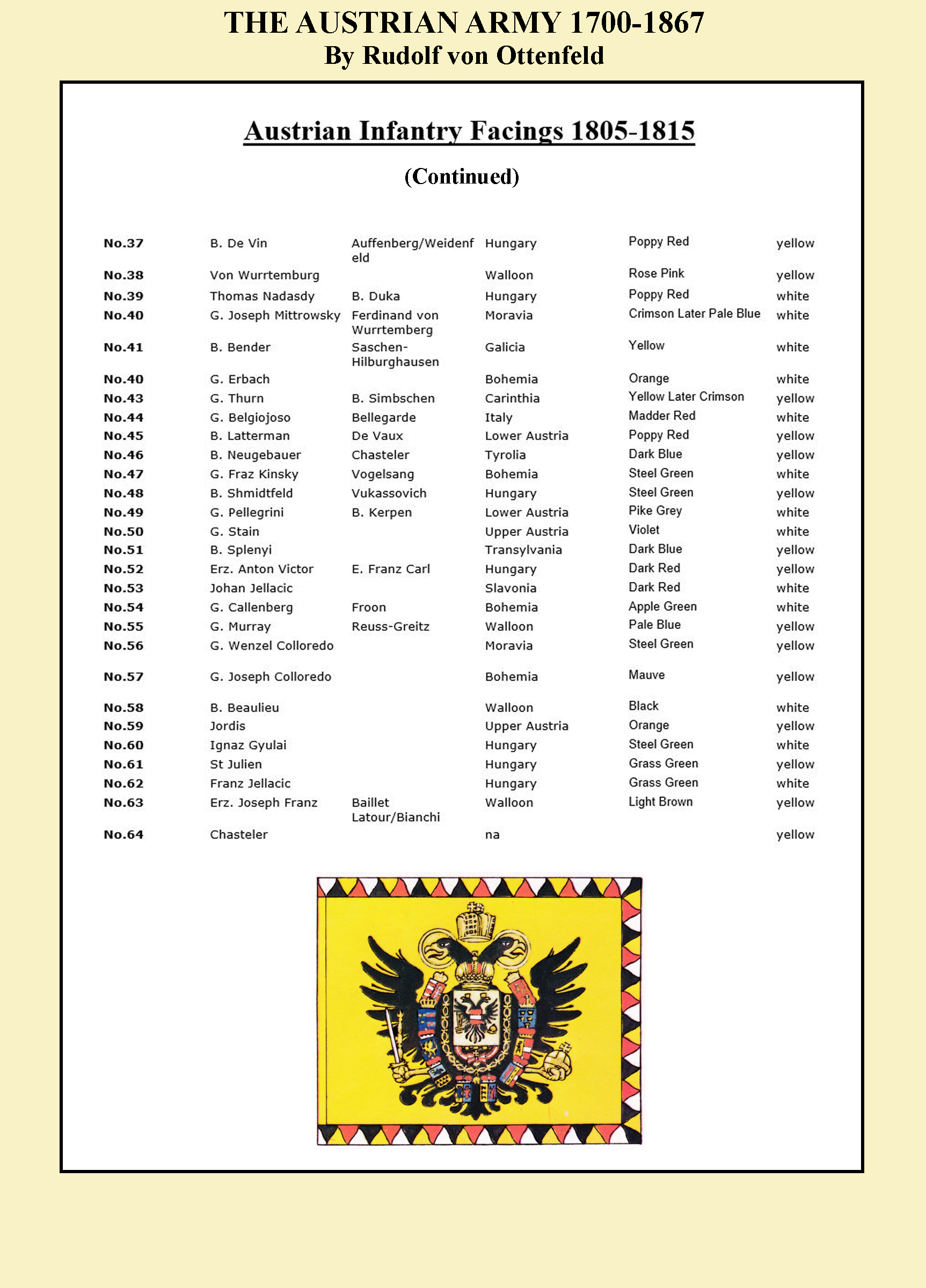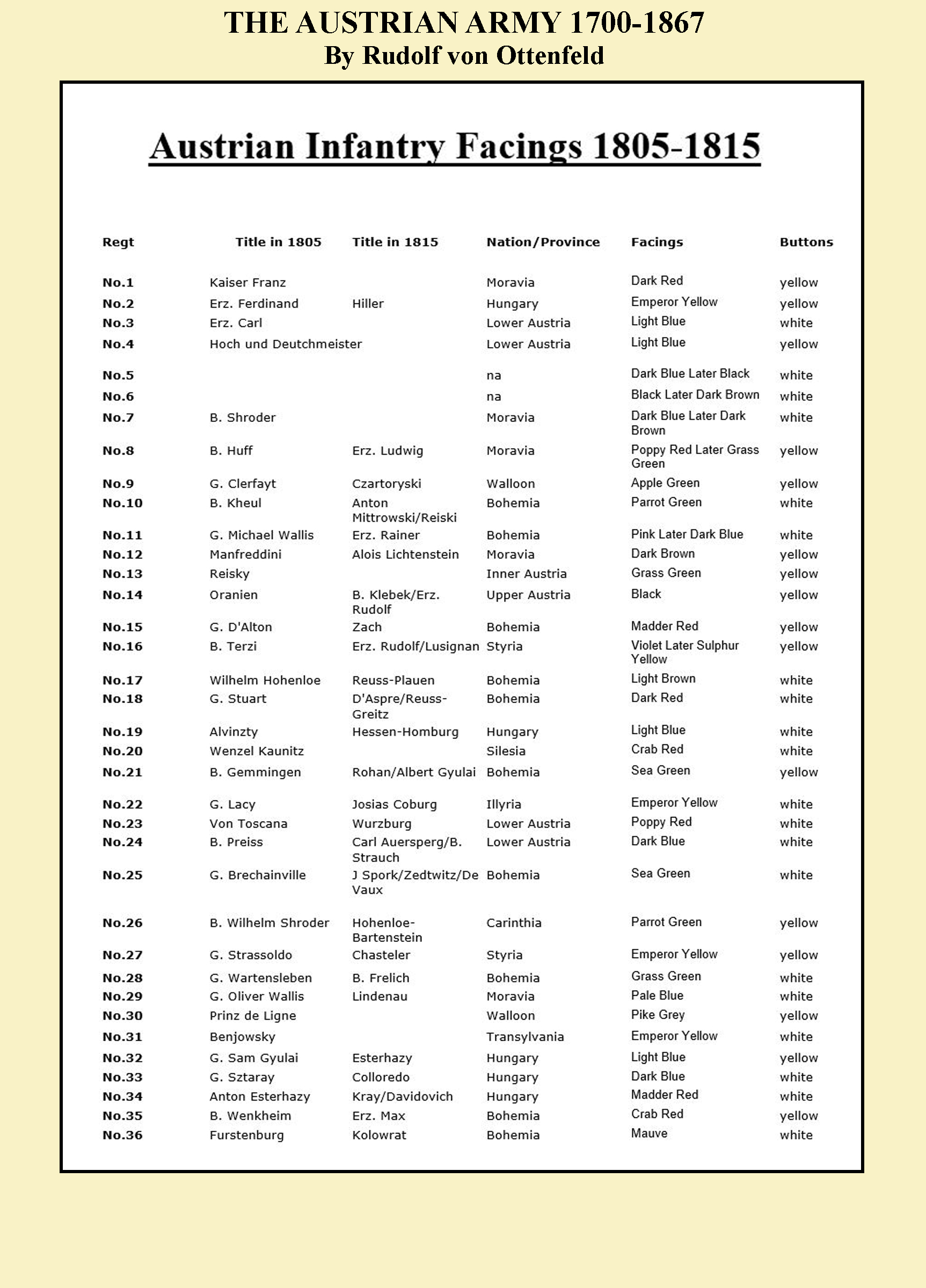THE WORLD OF MILITARY UNIFORMS
1660-1914
THE AUSTRIAN ARMY 1700-1867
By Rudolf Otto von Ottenfeld
Page 4
German and Hungarian Infantry 1809
This plate shows the new uniforms adopted after Austerlitz. The shako with peaks front and back, has replaced the helmet and the oak leaves have replaced the plumes. The two figures at left are from a Hungarian regiment and appear to have dark blue facings with brass buttons. The tight breeches of the soldier in the foreground has black and yellow ornamentation and the short boots rather than gaiters. The soldiers on the right have yellow facings and brass buttons. On the far right is an NCO distinguished by the yellow stripes at the top of his shako. He also carries the short sabre as well as the bayonet. Notice the black gaiters with brass buttons. The pack is now carried in the French fashion with the overcoat fastened to the top.
Jaegers 1809
By 1809 the Jaeger battalions were fully integrated into the infantry and had become effective skirmishers. The helmet was replaced by the top hat style headgear turned up on one side. Napoleon was highly impressed by their operations and writes about them on more than one occasion.
The green tassels and cords worn on the left shoulder were awarded for marksmanship proficiency and would remain a part of the uniform for jaegers and riflemen for many years. The black leather straps have been retained and the pack and straps are now of the French style as with the infantry of the line.
Cuirassiers 1809 - 1815
This is the uniform of the Austrian cuirassiers as it would appear through the end of the period. The helmet is now more classical in style as with other European armies. It was leather with a black over yellow crest and a sprig of oak leaves worn in place of the plume. The blackened steel breastplate was edged in gold for officers and brass for the rank and file. The red cloth lining is plainly visible in this plate as is the extra gold shield ornament worn on the breastplate by officers only. The sabre was carried in a steel scabbard.
The facings were worn as a patch on the collar and on the rounded cuffs, usually concealed under the gauntlets The trumpeter in the background has a red crest on his helmet and does not wear the breastplate. Officers and men of the cuirassier regiments rode black or dark bay horses while the trumpeters rode greys.
Hussars 1809 - 1815
The uniform of the hussar regiments changed little from 1806. The shako now appeared more bell topped but in other respects there was little change in dress. The red shako, brass buttons, and yellow lace indicate that this hussar is of the Erherzog Josef regiment. His saddlecloth is red and the sheepskin is plainly white while other sources describe them as black. As can be imagined in the cold, snowy weather, he is wearing his fur lined pelisse instead of carrying it over his shoulder.
Cuirassiers 1809 - 1815
This is the uniform of the Austrian cuirassiers as it would appear through the end of the period. The helmet is now more classical in style as with other European armies. It was leather with a black over yellow crest and a sprig of oak leaves worn in place of the plume. The blackened steel breastplate was edged in gold for officers and brass for the rank and file. The red cloth lining is plainly visible in this plate as is the extra gold shield ornament worn on the breastplate by officers only. The sabre was carried in a steel scabbard.
The facings were worn as a patch on the collar and on the rounded cuffs, usually concealed under the gauntlets The trumpeter in the background has a red crest on his helmet and does not wear the breastplate. Officers and men of the cuirassier regiments rode black or dark bay horses while the trumpeters rode greys.
Cuirassiers 1809 - 1815
This is the uniform of the Austrian cuirassiers as it would appear through the end of the period. The helmet is now more classical in style as with other European armies. It was leather with a black over yellow crest and a sprig of oak leaves worn in place of the plume. The blackened steel breastplate was edged in gold for officers and brass for the rank and file. The red cloth lining is plainly visible in this plate as is the extra gold shield ornament worn on the breastplate by officers only. The sabre was carried in a steel scabbard.
The facings were worn as a patch on the collar and on the rounded cuffs, usually concealed under the gauntlets The trumpeter in the background has a red crest on his helmet and does not wear the breastplate. Officers and men of the cuirassier regiments rode black or dark bay horses while the trumpeters rode greys.
Lancers 1809 - 1815
This uhlan (lancer) is of the 1st Merveldt regiment indicated by his yellow czapska. His canteen and equipment are plainly illustrated and the bottom of the lance pennant like the czapska was also yellow. This is the uniform worn by these troops as they finally forced an end to Napoleon’s reign. It should be noted that many of these uhlans were recruited from Polish Galicia. The uniform would remain little changed until 1867. This particular painting of Ottenfeld's has become an iconic illustration of a Napoleonic cavalryman.
Artillery 1809 - 1815
The Austrian artillery did not adopt the shako during the Napoleonic Wars. This plate illustrates an NCO in a practical litewka style jacket. He is armed with the short sword and carries a cane to distinguish his rank, as does the yellow braid on his bicorne hat. The gunner in the center wears the standard uniform jacket. Unlike other artillerymen of the period these troops do not seem to be armed with muskets and cartridge boxes. The gunner is armed with a short sabre and carries a pouch, probably for fuses slung over his right shoulder. His plain black bicornne has a black over yellow plume. The Austrian train corps continued to wear light gray with yellow facings. They adopted the infantry shako in 1890. It was quite plain and ornamented only with the cockade and a yellow pompom.
Engineer Corps 1809 - 1815
The sappers, pontonniers, and miners, who were the rank and file in the Engineer Corps, were all uniformed virtually the same. Bluish grey coats with red facings and the hats similar to the jaegers. There was only one battalion of each unit during this period all with quite special duties.
Pioneer Corps 1809 - 1815
The Austrian Pioneer corps was responsible for clearing a path for the army on the march. They were the largest group of the various engineer corps with eight battalions. Their uniform was simple gray with green facings. They wore the top hat (Hutte) style headgear during this period with a black over yellow plume. In addition to their various picks and shovels they were armed with the regular musket. The uniform was quite similar to that of the jaeger corps but was readily distinguishable by the white belts and straps rather than black.
Pioneer Corps 1809 - 1815
Austrian general officers would wear the same color combination until the end of the Empire in World War I. White coats and red trousers. This general wears the later pattern uniform where the stand and fall collar has been replaced by a simple, plain upright one and knee boots instead of jack boots. A grenadier from a German regiment presents arms on the General's right.
Volunteers and Militia during the Hungarian Insurrection 1809 - 1815
ADuring the entire Napoleonic period Austria and the Austrian people never could accept their defeat by the upstart French and their Emperor. Despite all the defeats and setbacks and the dissolution of the Holy Roman Empire Austrian nationalism only continued to grow. From 1805 to 1809, the period of the Hungarian insurrection, the Austrian people flocked to form new militias and volunteer corps or landwehr. Many of these corps purchased their own uniforms and equipment. Not as well trained or led as the regular army they were still a force to be reckoned with by the French, Italians and Bavarians against whom they fought.
NEXT
THE AUSTRIAN ARMY
1820-1867


